#spaceimageandsound
Explore tagged Tumblr posts
Text
Space, Image and Sound - Stress Testing
We needed to do some stress testing in order to validate our idea for our project. We did this by:
Leaving the projector up and running to test out the different screens
Using different materials to test if they showed better colour; single layer of sticker paper, double layer, and the grey tones.
Testing if the phones move despite being up for a long time and having the wall shake or any other disturbance from the surrounding area.
Securing a plinth to put our projector on

The only real issue we have had is that the projector might get bumped or shifted. We have tried to mitigate this by taping where our plinth and projector is meant to be however realistically in a showcase we would need to put up barriers to protect the device.
We will continue to work on the visual elements of the piece which we have started but still need some work. We also may need to try a different laptop or device as the program was heavily lagging when we tested it out on Kevins laptop.
1 note
·
View note
Video
youtube
Critical Framing:
“Interaction assumes that there are individual independently existing entities or agents that pre-exist their acting upon one another” (Barad, 2012). Intra-action challenges the idea of individual entities and instead suggests the world is one integrated system. “Individuals do not preexist as such, but rather materialize in intra-action” and constantly reconfigure based on their ongoing interactivity.
A person’s actions influence not just their own reality but also the reality of those around them. As we exist within and influence our environment, so do we impact the environment of those around us due to our systematic existence, both passively and actively. Our project explores this concept of intra-action and encourages people to be mindful of the influence others have over their own perception of the world, as well as the influence they have over others.
Changes/Reflection:
Our installation is made up of five images and five sounds files, each controlled by the motion of a participant. As people enter the active space they hear a new sound, and as they approach the screen the volume of their sound lowers, meanwhile a corresponding image appears and becomes more opaque on the screen. This continues gradually until the person reaches the front of the room at which point their image is very bright and their audio has become silent. As another person enters the space, another sound and image pairing is assigned to them. At this point the two (or more) participants’ motion causes their images and sounds to overlap and the overall appearance and sound of the installation is influenced by the participants intra-actions. The installation changes based on the participants’ movement, the participants are influenced to move based on the installation feedback, and the participants also influence each other. Without the participants the installation does not exist, they are part of the work, and the work materialises within their intra-actions.
The key theme of our project has shifted since our proposal. While looking into suggestions and the influence they can have over people we became more interested in the influence and interactions themselves. We had initially proposed potentially having a “closed loop of suggestion” by making an installation which causes the viewer to react, which in turn causes the installation to react etc. As the viewer observes the work, so does the work observe the viewer through the use of motion tracking or sensors. As we looked further into this idea and read through an interview with Adam Kleinmann (Barad, 2012), we began to realise that this closed loop reflects the idea of intra-actions. Interactions are between individual entities, but intra-actions are a system of sorts, where each element doesn’t exist on its own, but comes into being through their collective interactivity. In this way, the installation does not exist on its own, but through the intra-action with the audience members within it. In order for the installation to observe and react to the audience, we had intended to use motion tracking through processing and blob detection software. Unfortunately, we were unable to complete the code for the work in time and so instead tracked participants manually, by watching them and communicating their movement to processing through the use of a keypad. We were very pleased to find out during our feedback however, that people had thought they were being tracked by a camera and were not aware of our manual method.
Our initial proposal also suggested having a series of works displayed on different days, however with our new intra-action direction we didn’t want to separate the works, and instead choose to integrate elements from all our ideas into one central intra-action. Overall, we were surprisingly pleased with how well the installation went, as well as how the audience understood the work. They commented on how they moved back and forth based on what those around them were doing, that they wanted to be involved, and that they liked how the images and sounds became more complex and loud as more people were in the space. They also commented on a few things we had not considered ourselves which was the most interesting part of our presentation. One thing someone mentioned was “what if it was a sound/image that people didn’t want to see”. We hadn’t considered this before but would be interested to see how the system as a whole would react to this scenario. Would everyone else move to either the front or back to drown out the sound or hide the image? Or might they potentially force that person out of the system? This could be a very interesting project to explore in the future as it would likely reveal more about the nature of intra-actions, and whether a forced or undesirable intra-action could break a system, returning it to the form of interactions.
Reference:
Barad, K. (2012, Summer). Intra-actions. Mousse, 34(2), 76-81. Retrieved from http://www.academia.edu/1857617/_Intra-actions_Interview_of_Karen_Barad_by_Adam_Kleinmann_
2 notes
·
View notes
Text
Studio VI: 3D Printing!
So I’ve finally managed to get everything I need 3D printed, it did take a week and I was a bit worried about the sizing of the flower as a whole but it seems fine.



There’s quite a lot of space in the middle which I’m ok with because I’d like to try multiple ways of getting the petals to move.
I also got some plastic rings to put in between the petals and the ring so there isn’t any friction. The material is quite rough as well so I might think about painting the parts or putting some kind of finish on them so they don’t wear out.


I managed to get some flower heads for free at a Florist shop so I could see and feel the textures/patterns on a typical flower.


The patterns aren’t too overpowering which I think is interesting because with this flower that I’m making isn’t supposed to fool anyone, I would like to elaborate on that concept later.
1 note
·
View note
Text
Kia ora
Literally the bane of my existence this past week. More on that later.. Stefan the absolute legend managed to write up a code using an ArrayList that would be the base for my posting functionality. Merging Stefan’s code into my own proved to be time consuming as I’ve been trying to match it to the code that I already had. As a result, I had two sections of code that did very similar things on screen but did it in completely different ways. The code that I had used a very effective shuffle function which while it worked well for the side ads, it didn’t allow for the posting functionality and prepoulating the social media (which probably took 50+ lines in my code) could be achieved with a single line for each post. I believe that I’ve wasted a lot of time in this sense holding onto my old code just for the facts that it was code that i was proud of for making (since I had learnt a lot from doing it) and I had spent a lot of time making it. In the past 12 hours though, I decided that holding onto code that’ll make things hard for me isn’t the smartest idea. So I’ve cut out a significant section of the code. As a result, I’m probably further behind but I know that with this simpler code I can move ahead a lot faster.
With changing the code in this way I’ve come across a few bugs that I’m currently working around. 1. The ad posts aren’t randomised:

Roam Electronics seems to be our main sponsor at the moment
2. The posts in the second state produces an increasing number of duplicates of the user’s posts as the number of switches between the states increases:

This will have something to do with the number of textfields that are being produced so I need to find a way to clear the previous one with each state switch.
To test the functionality I’ve been using the line “Kia ora” which after the amount of bugs I’ve already had to solve has brought me a lot of trouble.
We had a switch in lecturers along with our group critique this studio time which was very beneficial to us. Ben really liked the idea that we had for our project and believed that we were on track to completion. Good one team. It was good to get Ben’s input on it though as he emphasised the importance of user testing (coming from perhaps a more game background). This was something that we initially wanted to do but put it on hold just to get the project moving - probably not the best thing to do. So, Reza will be experimenting with various aspects of our project to get more of an understanding of how people will react to it. We’ll adjust our project in accordance.
Chris and Jed have pretty much sorted the chairs with the push buttons this week:

For the buttons we staggered them in an attempt to allow for as much variation in the way that people sit as possible. Whether people only sit on the edge, skewed or with one leg up, at least one button should be pushed down.

The buttons have been hooked up in a parallel circuit so the as long as one button is pushed, a signal will flow.



The chairs have also been rigged up with rgb lights which can be controlled by the arduino. The purpose of this is to create unity throughout the project as the light combinations will reflect that of the different states of the social media. This will also be used in a UX way. Initially, we’ll just have one seat lit up (the one directly in-front of the keyboard and mouse) one someone sits in the lit chair, the second one will light up or flash (either instantly or once the person attempts to post). This should indicate to the user that there should be someone else in the chair.
1 note
·
View note
Text
SIS: Project summary
youtube
SOMA is an interactive art installation exploring an idea of control of people in a society, what its main causes are and in what form said control is manifested. Generally, control can be viewed as self-inflicted as well as imposed by an outside party but here they're explored as if society is an extension of our individuality, mind, and body (A. Watts), therefore, there's no separation between the types of control.
The final concept has been reached through iteration cycles consisting of discussion, prototyping, and criticism and the conceptual journey this project embarked on has been remarkable due to a wide range of ideas and mediums of presentation explored. Each idea has been enquired into under two lenses: meaning and technological means of conveying an idea. That approach allowed us to probe into drastically different mediums so that we would have a solid understanding of various art forms and how they can be applied to a concept our group is fully satisfied with.
The final piece is a combination of ideas about societal control from a novel Brave New World by Aldous Huxley and a simple yet engaging technological demo from eelslap.com allowing an audience to control an animation by moving their mouse cursor along the screen. Huxley's novel showed his characters being controlled through a drug Soma, endorsed by the government, that they willingly take whenever they feel unnerved. The drug is available only in the civilised part of the society, the uncivilised territory reserves to pain and self-harm as a control method. We decided to use a video, later turned into a GIF, projected onto a wall as the medium and have represented control and submission by submerging young kids, brother, and sister, underwater. An audience has to decide who of them is sinking by operating a lever that in return controls a GIF, there's no middle ground, both kids can't be under or out of the water at the same time, that way the audience is presented with a decision they inevitably have to make.
by Trak Gray, Matvey Tarchutkin and Tobias Heeringa
1 note
·
View note
Text
SpaceImageSound - Setting up
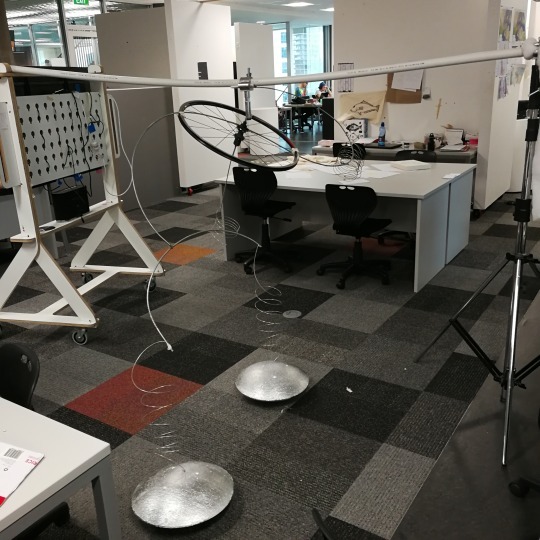
Here is our sculpture after completing all of the metalwork and applying our final coat of metallic paint.We prototyped how it would hang from above in class with a plastic pipe.
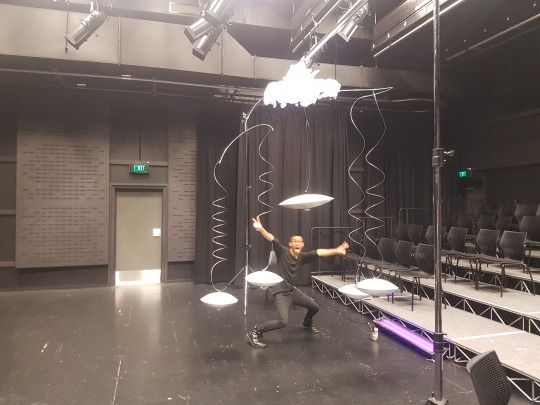
We then moved our sculpture down to the performance labs where we would have enough space to set up our installation. We were able to get two supporting stands which held a metal beam 3 meters high. We clamped our wheel and UFO’s to the beam and then tweaked all of the hanging UFO’s so that they would hang from the right individual heights.
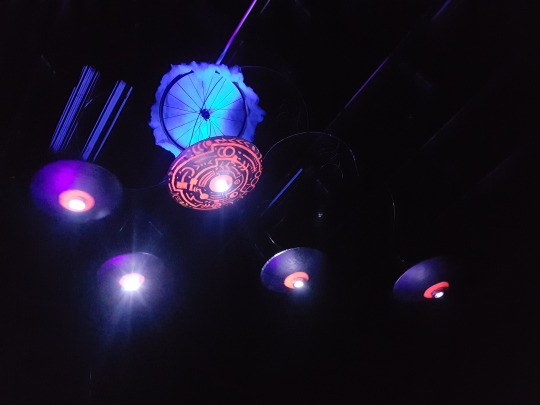
We then did final touches on our sculpture by setting up the lighting which consisted of LED’s and a UV light. We used our UV paint to then paint rings on each of the smaller UFO’s and a design on the Mothership UFO. I was very happy with how they looked in the dark!
0 notes
Photo

Completed Tahaki Reserve Installation, two flags placed in separation to channel the weak signal of the land 🏳️🚩@alonso.elec #SpaceImageandSound #ctec700 (at Tahaki Reserve) https://www.instagram.com/p/BpElSatA1ng/?utm_source=ig_tumblr_share&igshid=naachvry9nd7
0 notes
Text
Playtesting The Narrator

(above image courtesy of Michael)
Last couple of days we set up and tested our project for Space Image and Sound, and as you can see from the image above it is still a bit janky (I kind of like it though as it still allows us to switch things out as needed).
Even though many wires are involved, the voltage isn’t high enough to shock anyone, and tape seemed to hold everything together which is lucky since the mechatronics lab shut down before we got to solder anything.
I think that the rapid prototyping process was great. Creating something physical showed us the limitations we had, instead of just assuming things like a kinect or motion sensor could be added easily.
I feel the project left our original idea of enhancing mundane objects through adapative audio, and is more about utilising objects cooperatively for a playful outcome.
youtube
Cooperative is quite central now to the project, even though up until a couple days ago the idea was for the engagement to be a solo experience.
I hope Michael expands on the playful aspects of this project, now that we are finishing up, and he branches off continuing it for Studio. I will try continue to participate as much as I can without being overbearing, as I have really enjoyed this project.
Looking forward to seeing what the final outcome for this is in showcase.
1 note
·
View note
Text
Space, Image and Sound - Week 6
Last week we presented our project in a Crit session to the class. From the crit feedback we learnt that we needed a better way to make the mobile phones. Currently they are just made out of cardboard and lack the impact we were hoping for. Our fellow peers suggested a few options such as MDF or laser cutting to make the phones seem realistic however Clint remembered that he had some leftover phones from a previous students project and has allowed us to make use of them.

These definitely help improve the quality of the project however we just need to figure out an solution to how we can project onto the screens without glare.
Our solution we are working on at the moment is to use sticker tape to cover the individual screen areas and see if we can still project onto them after. Sheena did a test where she blue tacked a few of the phones onto the wall to test whether they would stay for an extended period of time. SO far the phones seem to be holding so we will be using blue tack.

In regards to the media we will be displaying on the screens we still need Stuart to give me some test material so that I can try running it through HeavyM
1 note
·
View note
Text
SIS (Space Image and Sound)
Perception descriptor:
Perception, the ability to see, hear, or become aware of something through the senses (“perception | Definition of perception in English by Oxford Dictionaries,” n.d.). In this project, the main highlight is perception. The perception of your senses, hearing feeling and being in the moment.
The scenario of the installation is a room, more of a large room where you can host twenty people plus. The mood of the room will be a party room, a social event when people get together to have a good time. The mood will be light and welcoming to all, even if they are strangers and people out of my degree.
At the back of the room, there will be a television screen or a wall projection. The projection will be consistent of a general scenario. This scenario will have a portion displayed that is normal, as if it a stock picture, but there will also have another portion. This other part can be a crash, an accident or maybe a crowd fight that has occurred. Though note that only the ‘good’ (“good | Definition of good in English by Oxford Dictionaries,” n.d.) will be shown.
The audio of the social function will be social music. The playlist will be consistent of pop music (“Top 100 Songs | Billboard Hot 100 Chart,” n.d.) that will be derived from research and what is momentarily popular. Another alternative is to have dance music that will be in house produced.
There will also be snacks and drinks available on a table with a pair of headphones beside with the label ‘perception’.
The audio of the headphone that will be played is the audio portion of the horrific accident that ha happened on the video at the back of the function. Either if one has the curiosity to put on the headphones, they will notice what is happening and the installation will begin.


Conceptual Statement:
In the progression of making the concept of perception. I had to be clever and go back to my roots. After thinking about how your senses heavily influences your perception, I started to analyse my feelings towards today’s society. Throughout the project’s brainstorming faze, I wanted to heavily rely on audio to portray my story. This was due to fact that I am an audio practitioner and designer. I had many discussions with old team members between projecting something until a wall, making a game that would demolish social issues and play with images. None of those ideas appealed to my liking. I thought I needed something that was more me, more audio focused.
I had to address my daily actions. To getting up and traveling from point a to b. I have always concluded myself in my own solitude and ignoring what is happening around. After daily conversations with my peers and fellow work mates, the realization became that they did the same actions as I did.
Many readings later I came to a standing that maybe this was a social issue that I need to explore (Andrew, 2008). Is it the fact that you go around and neglect the bad that is around you? People do not admit it and they carry on with their daily lives.
The weak signal of the project would have to be broad. I applied the concept of the weak signal as something that we neglect to see, hear or imagine. The weak signal of my project is awareness better yet perception of our surroundings, hence the name perception.
I have people around in the room to symbolize that we live in a society crowded with people. The symbolism shows that we seclude our self in drinks and parties and doing our own things (Bogt & Engels, 2005). Another annotation I can make is; in a substance, this scenario is a crowded street and we are the people with headphones on being ignorant to our surroundings.
The backing image is to conceptualize the true nature of our background that we neglect due our focus on our own life. I want to show you that there is more to your own life, that there is more to the bigger picture (“Seeing the Bigger Picture,” n.d.).
On the audio aspect, I will conceptualize the scenario of an accident. I will have sirens going on the background, people yelling and crying for help. This choice is made to be horrific, to have an impact on the listen and to make the viewer understand the weak signal of my art installation. This will be all transmitted through the headphones that will be placed on the table.
Overall, no this is not fully complex to point I must go out my way and make an obscure object. The concept and meaning behind the project are what makes it a weak signal project and mainly complex.
I will need a monitor, or a television provided by colab. Also, a sound system that is also available by colab. I will be using FL studios (“FL Studio,” n.d.) to generate the audio that will be played through the headphones. I maybe get stock videos from the internet to save time and money. They will be all credited.
Audio samples:
youtube
youtube
Bibliography:
(3) Best commercial 2014 Car Crash Commercial New Zealand - YouTube. (n.d.). Retrieved August 26, 2018, from https://www.youtube.com/watch?v=3qNjt04bpQM
Andrew, M. (2008). Anti-Social Behaviour. McGraw-Hill Education (UK).
Average Life. (n.d.). 10 SHOCKING AMUSEMENT PARK ACCIDENTS CAUGHT ON CAMERA. Retrieved from https://www.youtube.com/watch?v=emD2ilOGaNc
Bogt, T. F. M. T., & Engels, R. C. M. E. (2005). “Partying” Hard: Party Style, Motives for and Effects of MDMA Use at Rave Parties. Substance Use & Misuse, 40(9–10), 1479–1502. https://doi.org/10.1081/JA-200066822
Burger, J. M., LaSalvia, C. T., Hendricks, L. A., Mehdipour, T., & Neudeck, E. M. (2011). Partying Before the Party Gets Started: The Effects of Descriptive Norms on Pregaming Behavior. Basic and Applied Social Psychology, 33(3), 220–227. https://doi.org/10.1080/01973533.2011.589300
FL Studio. (n.d.). Retrieved August 26, 2018, from https://www.image-line.com/flstudio/
good | Definition of good in English by Oxford Dictionaries. (n.d.). Retrieved August 26, 2018, from https://en.oxforddictionaries.com/definition/good
perception | Definition of perception in English by Oxford Dictionaries. (n.d.). Retrieved August 26, 2018, from https://en.oxforddictionaries.com/definition/perception
Seeing the Bigger Picture: Life Maybe Better Than You Think. (n.d.). Retrieved August 26, 2018, from http://www.psychologytoday.com/blog/the-gift-maybe/201501/seeing-the-bigger-picture-life-maybe-better-you-think
Top 100 Songs | Billboard Hot 100 Chart. (n.d.). Retrieved August 26, 2018, from https://www.billboard.com/charts/hot-100
What happens to you, psychologically, if you socially isolate yourself? - Quora. (n.d.). Retrieved August 26, 2018, from https://www.quora.com/What-happens-to-you-psychologically-if-you-socially-isolate-yourself
0 notes
Photo
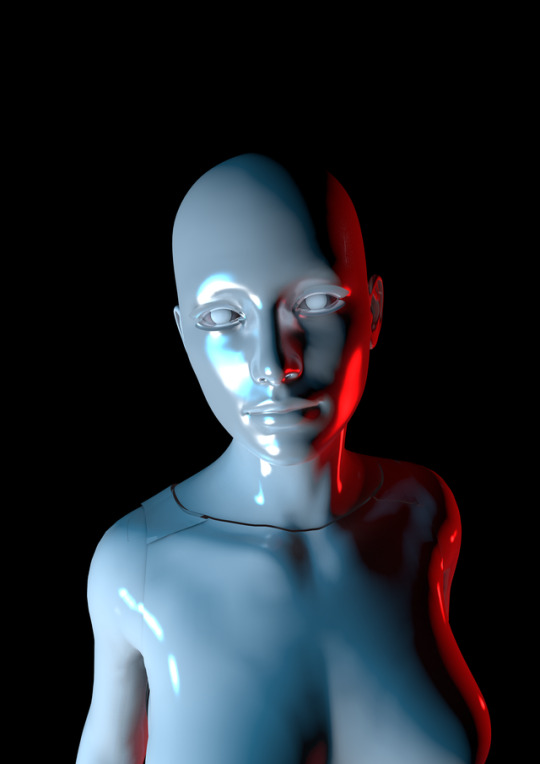

Created this A4 Render for ur poster. Shows our cyborg and the lights illuminating on the reflected figure. Took the rendered version into lightroom to add a filter and grain to it.
2 notes
·
View notes
Text
Studio VI: Getting an idea of material and form.
So with the concept I have I needed to start interrogate it to find a number of ways to try and out the whole thing together.

The question was how I was going to make the petals open and close so I looked up some examples of other projects a while ago and found heaps on YouTube.
I was quite inspired and decided to start fabricating my ideas on making this work.

Those bracket shapes will be the parts that hold the petals and pull them in/push them out as the ball rises.
Now I needed to decide how I was going to allow the petals to move in the first place.

My idea so far is to use the piping I have in the current model and have a wire fed through around the pipe then I’ll have a small tube-segment attached the the bottom of each petal which will have to be straight so the petal can move which the wire can hold, then I’ll need a plastic ring in between the bit that moves and the bit that doesn’t so there’s not much friction.

I’m going to get this petal 3d printed to see and feel the material and size so I can decide what will be appropriate for my end goal. I’m trying to leave a lot of room for change because I know there will be change.
1 note
·
View note
Text
(Post)er

This week I’ve been tweaking the code and replacing the placeholders with the images that we are most likely going to use. Also, aligning everything to the positions that Reza had specified in illustrator. As a result, it’s becoming a lot easier to see what the social media will actually look like and how it will function. A major problem that I identified in my previous blog post was the mouse and how people may try to click all over the page. After discussing this with the team we’ve decided that the best way to counteract this is the glue the mouse to the desk during open evening. This will take away a lot of the potential interactive element but it’ll mean that we can focus on only the core elements of our social media (scrolling, posting). This should also make it clearer to the user that these are the only things they should be doing. Main thing left is to get the posting functionality done.

We’ve started brainstorming some ideas for the poster as well. Since the brief calls for us to challenge what a poster is we’re looking at other ways we can get the idea of our project across. For this, I remembered a talk that was hosted by Pete and the speaker talked about his advertising agency’s work with the musician Skrillex. To release his first album they didn’t use traditional advertising strategies such as posters, billboards etc. They had Skrillex mention on twitter that he was having fun playing a certain app. A couple of days later a timer appeared in the game which then released each song one by one. (Lien, 2014). The speaker here emphasized the use of timers, delays and creating links in different places. With this in mind I suggested to the group to have our “poster” outside of the open evening - To have a mini installation, an advertising campaign or something similar in the days leading up to the open night. If there was a handful of people who saw our “poster” outside of the open evening and then with no direct link to the showcase saw our open evening project. I think that it would spark a massive amount of interest and leave a more lasting impression on the viewer.

1. Lien, T. (2014, March 11). Skrillex launches full-length album within mobile game Alien Ride. Retrieved September 14, 2017, from https://www.polygon.com/2014/3/11/5497016/skrillex-launches-full-length-album-within-mobile-game-alien-ride
1 note
·
View note
Text
SIS: Dunking kids into a pool

On 14.05 Sunday we have filmed all the footage we needed for our project, the main difference from a test footage we've done a few weeks prior was us lowering young talents into a pool horizontally and not upside down. There were a few reasons for this change:
Uncomfortable and awkward holding positions for people lowering and a person being lowered into a pool
Multiple takes would take a long time to shoot as being lowered underwater upside down is really stressful for actors
Stability, it was rather difficult to stabilise the body/head of an actor

We came up with a more eloquent solution which Trak built: a rig allowing us to position a person horizontally to capture the water rushing in or out of their face as they're being lowered into a pool with a GoPro strapped above their head. It also has a space behind actors' heads for sliding in a piece of plastic that acts as a background for easier post-editing.
Toby and Trak were in charge of submerging our actors while I was doing camera work — a task I was happy with as I didn't feel enthusiastic about jumping in and out of cold water for a few hours. The time before filming was somewhat tense for the team as we had to do multiple trips around the city to get everything we needed (GoPro, SD card, kids), but that unnerving state has quickly disappeared when we met our actors: Luca and Elissa, 9 and 14 respectively, extremely energetic kids who were doing flips on a trampoline between the takes. It seemed as if they're never tired and the whole experience of working with them has most definitely brightened up my day, that means a lot to me as usually I'm lost and awkward around kids. You just can't help but get infected with their joyous playful attitude.

Now that the filming was done, our next step was to build a final version of a lever system. Up to that point, the only material we've considered was wood, something we're familiar and confident with working, but after visiting 3D labs for design advice we saw an enormous amount of metal scraps that would fit our needs perfectly and we've ultimately decided it would be better if we welded it. It would make our device not only stronger and more stable but the flexible nature of the material allows us to experiment with a design more. Moreover, I've never done welding before and it's something I'd be interested learning, what a perfect opportunity.
Overall, this project had a very interesting concept development road and at first glance, it's difficult to connect our initial idea with what we have now. We started out with wanting to make a difference in NZ's society by trying to tackle one of the myriads of problems but essentially ended up with an art installation after realising that bringing awareness is something we can realistically hope to achieve. I, however, believe that the final idea wouldn't be as strong if we didn't go through so many concept iterations and am very happy with how it turned out.
1 note
·
View note
Text
SpaceImageSound - UFO Baby Mobile - Working with Metal
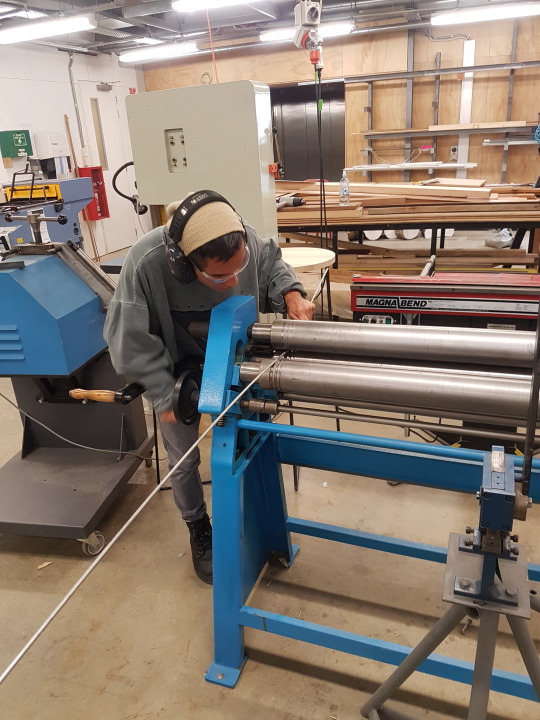
Above is a photo of EJ bending our long metal rod into the S shape which we has intended. This took us a few tries to get the S shape but we got there in the end. Below shows our bike wheel which will be the main source of movement for our structure. We got a piece of metal welded to the hub of the bike wheel so that it could connect to a clamp which would allow the wheel to hang from above. this photo also shows our S shaped metal rod which will be used to hang our UFO models from.
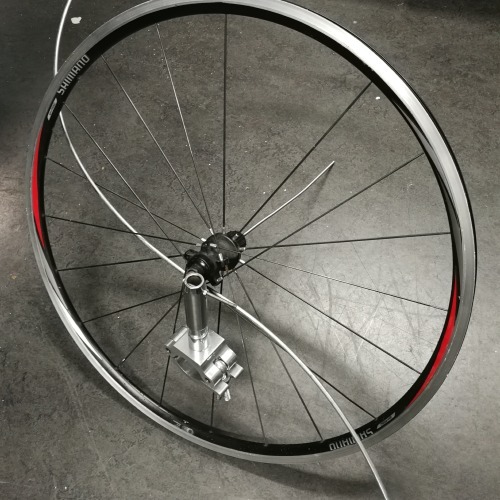
0 notes